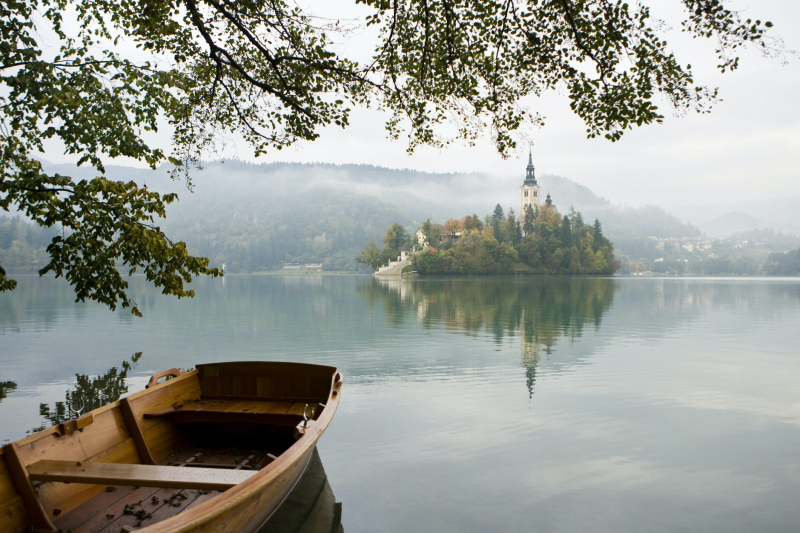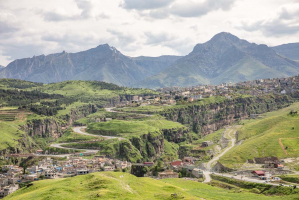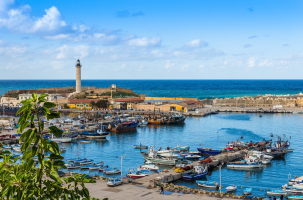Top 10 Things to Know Before Traveling To Slovenia
Slovenia is a complex crossroads of cultures and topographies, perched where the Adriatic and Eurasian tectonic plates meet, drawing traditions from both sides ... read more...of the divide. It's a country where everyone can find something for themselves, whether it's active experiences in the midst of pristine nature, city breaks topped with culture, relaxing vacations in spa centers, or gastronomic pampering with local flavors in first-class restaurants. Here are ten things to know before traveling to Slovenia, as well as reasons why you should visit the country.
-
Slovenia, located in the heart of Central Europe, has benefited from the influence of its neighbors. The neighborly influence is palpable in the varied architecture, which appears to be cut from the same cloth as many iconic Italian and Austrian towns.
Slovenia has a rich culinary tradition as a result of its climate as well as its location at the crossroads of Central Europe. Slovene cuisine reflects Mediterranean, Alpine, and Eastern European cultures. Meals are an important part of Slovene family life, and meeting friends for a snack or a glass of wine at a café is a common social activity. Although each region of Slovenia has its own specialties, the majority of the country's oldest traditional dishes are made with flour, buckwheat, or barley, as well as potatoes and cabbage.
Slovenia's towns have many well-preserved buildings from the 1100s to the present day, representing various architectural styles. The church at Sticna Abbey and Podsreda Castle are two fine examples of Roman-esque architecture in Slovenia. Architecture from the late Gothic period can also be found. Many buildings in Slovenia's older towns, particularly in Ljubljana, are in the Italian Baroque style. This is unquestionably one of the most interesting things to know before traveling to Slovenia.

slovenia-convention.com 
themayor.eu -
Slovenia, located between Italy and Croatia, has just over 28 miles of coastline along the Adriatic Sea, with endless coastal views and hidden beaches. The Slovene Riviera, which is home to some of the region's most beautiful and ancient towns, stretches from the northernmost cape of Debeli Rti, by the Gulf of Koper, before winding down south along stunning shoreline to the village of Seovlje, by the Gulf of Piran. Slovenia's scenic coastline is by far one of the country's best-kept secrets. It provides visitors with a rarely seen glimpse of the Adriatic Sea.
The Secovlje Salina Nature Park is located on the Slovenian coast, near the border with Croatia. The famous Piran Salt Pans can be found here, where salt is still produced in the old-fashioned way. Piran is a small town with a lot of culture and history. It has a lively town center, delicious seafood, and a maze of beautiful narrow streets lined with colorful old houses. Svetilnik (lighthouse) Beach is a large grassy area on the outskirts of town with several bars, a pebble beach, and a jetty.

czickontheroad.com 
czickontheroad.com -
Ljubljana is rightfully one of Slovenia's top destinations, with incredible sights all over the city, but don't leave without experiencing Ljubljana's other side. Leave the picturesque square of Preernov Trg and head east along Trubarjeva Cesta, passing busy street food establishments, cafes, and bars. Continue to the Metelkova district of Ljubljana, which has become the city's de facto art district. What were once military barracks are now transformed into studios and hedonistic nightclubs. There are also two of the country's most interesting museums here: the Museum of Contemporary Art Metelkova and the National Museum of Slovenia – Metelkova.
Every stroll down the cobblestone streets in Ljubljana yields a new inspiring story. Climb to the castle, cross many beautiful bridges, and come to a halt at Preeren Square, which houses the beautiful Franciscan Church. In the immediate vicinity, you can also visit the town hall, the cathedral, and some fascinating galleries and museums. The mastermind behind the city's modern image is the greatest Slovenian architect, Jože Plečnik. In 2021, a selection of his works will be inscribed on the UNESCO World Heritage List.

dulichvietnam.com 
tripadvisor.com -
Slovenia's tourism authorities have developed a number of free routes for independent travelers, with the goal of providing DIY explorers with the tools they need to visit less touristy areas of the country in a responsible and sustainable manner, often by hiking or cycling.
The benefits to travelers are obvious. These routes include a wealth of free and simple-to-follow information that will take you off the beaten path and give you a chance to see rural Slovenia up close and personal. The country benefits as well, because visitors moving at human speed are naturally dispersed, reducing traffic and over-tourism in more popular areas.
The Juliana Trail, an easy-to-follow hiking path that circles Triglav National Park, is possibly the most popular itinerary. The Bike Slovenia Green: Alps to Adriatic cycling route connects Kranjska Gora to the Adriatic, while the Walk of Peace trail follows the Soa River, one of Slovenia's most beautiful hiking and kayaking destinations.
Cyclists with strong calves should take advantage of the newly launched Slovenia Road Cycling Loop, which takes road warriors around the country to the best climbs and descents. For those looking for a multi-sport adventure, the Slovenia Green Solava Panoramic Route combines cycling and hiking in the mountains north of Ljubljana. This is unquestionably one of the most interesting things to know before traveling to Slovenia.
lonelyplanet.com 
lonelyplanet.com -
It's easy to get caught up in Slovenia's western half's beauty, proximity, romance, and popularity. The capital, the Julian Alps, the Kamnik-Savinja Alps, the Soa Valley, Lake Bled, Lake Bohinj, the country's Gorika Brda wine communities, the hilly Karst Region, and the Adriatic Coast are among the attractions crammed into this area.
It would be a travesty, however, for those who want to truly experience Slovenia to overlook the country's eastern side. Culturally similar to the Balkans, this half of the country is just as interesting and beautiful, and it's also less crowded due to the buzz surrounding western Slovenia.
Begin your exploration of Maribor and Ptuj, which are linked by the Drava River in the country's northeast. There are numerous spa and wellness resorts in the country's central-eastern region that are well worth visiting. For history buffs, no trip to Slovenia would be complete without a visit to the Sava River in the southeast, where dramatic castles dot the landscape.

overhere.eu 
roadaffair.com -
Slovenes will not greet strangers as quickly as Americans do. That doesn't mean they're not friendly; they're just a little reserved. However, one of the greatest pleasures of visiting Slovenia, particularly in mountain villages, is asking locals for recommendations on what to see and do.
Making contact is more than just saying hello; it's also a great way to learn about the country firsthand. Travelers who enjoy trekking, in particular, will benefit from local directions and tips, and sharing a cup of coffee or a glass of schnapps is part of the camaraderie of hiking in Slovenia. Slovenes are by nature devoted to their homeland, so every encounter is an opportunity to learn the lay of the land.

dreamstime.com 
thegeographicalcure.com -
Slovenes are hardworking and practical people. Citizens often prefer to get around on foot or by bicycle whenever possible, rather than always getting behind the wheel. Using your own power to get around isn't just a good way to stay fit; it's also often faster and more convenient than taking public transportation. Travelers who are unfamiliar with a city that makes extensive use of its bike lanes will almost certainly receive an etiquette lesson soon after arriving. Walking into the designated cycle lanes will result in a bell ring and possibly a stiff word or two.
If you want to join the throng, bike rentals are available in many locations across the country. The public BicikeLJ bicycle-sharing system in Slovenia's capital makes it simple and inexpensive to explore without ever putting a key in a car's ignition. Mountain bikes of reasonable quality can be rented from tourist information offices, hotels, and outdoor activity providers for highland exploration.

kimkim.com 
cyclingslovenia.com -
Roads and Driving are the important things to know before traveling to Slovenia. The country has only about five major roads, making it very easy to travel throughout the country. They do have a network of roads throughout their suburbs and cities, but they do not have a million interstates or anything else that complicates driving directions. Slovenian roads all lead to Ljubljana, the country's capital. This makes it extremely simple to drive between the major cities you'll visit during your Slovenian vacation.
There are no "traditional" toll roads where you must stop to pay a machine. Simply make sure there is a valid, non-expired vignette sticker on the upper corner of the windshield on the driver's side if you rent a car. The speed limit in built-up areas is 50km/h, 90-110km/h on open roads, and 130km/h on highways. There are also an increasing number of zones where the speed limit is 30 km/h, as indicated by the sign 'Zone 30.' Although radar detection equipment is not prohibited, if it interferes with police radar signals, you may be fined €400.

kongres-magazine.eu 
kongres-magazine.eu -
Slovenia is a wonderful year-round destination due to its fairytale landscape and unique combination of Mediterranean sun and snowy Alps. For a country the size of New Jersey, Slovenia has an incredibly varied climate in three distinct zones - something to keep in mind when planning activities for your vacation. You'll find a moderate alpine climate in the northern mountains, with longer, colder winters than the rest of the country. However, summers get warm and offer slightly cooler temperatures as an escape from the summer heat elsewhere.
Summer is the busiest season for visitors, but it's also the best time to enjoy Slovenia's beautiful lakes, rivers, and Adriatic coastline. Autumn brings beautiful foliage and mild temperatures ideal for hiking. The colder months are snowy and icy, attracting a large number of skiers to the mountains. But if you really want to avoid the crowds, go in spring - it's by far the quietest season for exploring Slovenia's natural wonders and medieval castles.

kimkim.com 
summittravelhealth.com -
When it comes to beverages, Slovenia's drinking water, one of the things to know before traveling to Slovenia, is flawless. Drinking water – straight from the tap – is referred to as "pitna voda" in Slovenian. Their water is delicious, especially in Ljubljana. This is a city which can be proud of its clean drinking water. Also elsewhere in Slovenia, tap water is of good quality and suitable for drinking. While strolling through Ljubljana's streets, you can quench your thirst for free at public drinking fountains, which are open from April to October. However, it is recommended that you let the water run for a few moments before drinking or filling your bottle for sanitary reasons.
You can rely on this Slovenia tip: there is no need to buy bottled water in Ljubljana since it would be a shame to unnecessarily buying bottled water since the plastic sucks for the environment.

visitljubljana.com 
sloveniatimes.com































